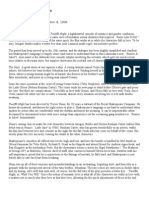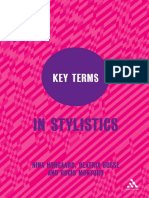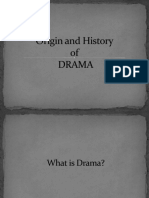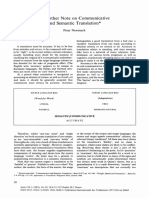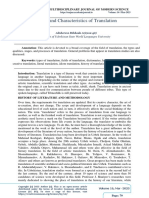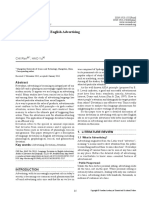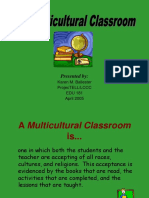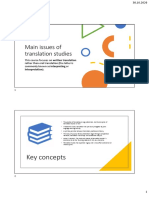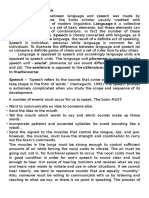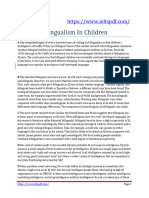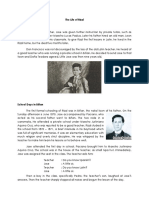Guide To Poetry Analysis PDF
Guide To Poetry Analysis PDF
Uploaded by
Anissa GeddesCopyright:
Available Formats
Guide To Poetry Analysis PDF
Guide To Poetry Analysis PDF
Uploaded by
Anissa GeddesOriginal Description:
Original Title
Copyright
Available Formats
Share this document
Did you find this document useful?
Is this content inappropriate?
Copyright:
Available Formats
Guide To Poetry Analysis PDF
Guide To Poetry Analysis PDF
Uploaded by
Anissa GeddesCopyright:
Available Formats
A Guide to Formal Analysis of Poetry
Obviously not every question will be applicable to every poem. Moreover, many questions will have to be revisited multiple times as your analysis of the poem proceeds, an interpretative phenomenon called the Hermeneutic circle. I: Content Does the poem have a title? Remember that modern editors have invented the titles of most classical texts. Consider why the editor may have appended this title but do not let it color your own interpretation of the poem. What are the theme(s) of the poem? To some extent your understanding of the theme of a poem will develop as your analysis proceeds. o Is the theme directly or indirectly stated? o If there are multiple themes; does the poem shift from one theme to another or are the themes interwoven? What is the setting of the poem? o When and where does the poem take place? o Is the setting closely linked to a specific time and/or place or does the narrator aim at universality/timelessness? Who is the narrator? o Is the narrator implicit or explicit? o What (grammatical) person and number is the narrator? Does this change in the course of the poem? o Does the poem invite you to equate the narrator with the author? Does the poem have an internal addressee or is the implied reader the assumed audience? Does the poem contain characters besides the narrator and explicit audience? o Do these characters have agency (i.e. they act and/or speak in their own right) or does the narrator report their actions and/or statements? What is the mood of the poem? somber/serious/joyous/ironic/satiric... o Is the mood consistent throughout the poem? What is the implied world outside of the poem? o What is the antecedent scenario? What has been happening before the poem starts? What has disturbed the status quo and set the poem in motion? o What is the consequent scenario? What state has been reached to bring the poem to a close? Does the poem anticipate subsequent actions? What allusions are present in the poem? o Are the allusions citations or evocations? o Do the allusions reinforce or subvert the explicit meaning? II. Structure What is the genre and meter of the poem? Does it deviate from the expectations of its genre or meter? Does the poem have a rhyme scheme? Rhyme at the verse-end is extremely rare in antiquity. Internal rhymes, i.e. between the first and second section of a line or section, are more frequent but still uncommon in most ancient authors. Can the poem be divided in sections? o How many sections? Where are the breaks? o What are the formal sections (stanzas, stichic lines, etc.) of the poem? Do the formal sections match the poems thematic sections? When looking at thematic structure, you might look for conflicts, ambiguities and uncertainties, the tensions in the poem, as these give clear guides to the direction of meanings in the poem, the poem's 'in-tensions'.
Do the sections match the punctuation? Remember that all punctuation in classical works is the product of editorial, not authorial, decisions. o Can the poem be divided differently? What variations in meaning do the various divisions yield? Where is the climax of the poem? Is there a climax? What is the emotional/rhetorical curve of the poem? a crescendo? an hourglass, a steep peak/fall? Are words and/or constructions repeated and/or varied in the sub-sections of the poem? What tense(s) does the narrator employ? How do these relate to the poems setting? o
III. Style Is the poems language primarily literal or symbolic? What is the narrators stylistic register? formal/informal/colloquial/slang How would you describe the syntax of the poem? As declined languages, Latin and Greek allow the author a massive degree of flexibility in the placement of words within a sentence. Is the syntax simple, disjointed (hyperbaton), or interlaced (synchysis)? Does the poem demonstrate an abundance of any stylistic, grammatical, or morphological forms? IV: Poetic Effects: does the poem demonstrate: imagery or figurative language symbolism metaphor and simile consonance or assonance alliteration, anaphora, anadiplosis, or onomatopoeia technopaignic effects anacoluthon aposiopesis or paraprosdokian chiasmus hyperbaton hysteron proteron punning or word play pleonasm syllepsis or ambiguity
V. Hermeneutic Questions: How do the poems content, structure, style, and poet effects combine to create the meaning of the poem? What is the purpose of the poem? Persuasion? Catharsis? Entertainment? Can you imagine the poem written in a different person, or a different tense, or with the parts rearranged, or with a stanza added or removed? What does the poem reveal about the narrator/author/audience?
You might also like
- Cpar PPT Lesson 1&2 Various Contemporary ArtDocument64 pagesCpar PPT Lesson 1&2 Various Contemporary Artjaslor100% (18)
- Prentice Hall Literature Platinum Level Review and Assess AnswersDocument8 pagesPrentice Hall Literature Platinum Level Review and Assess Answersc5m07hh90% (1)
- Module 1-2 Understanding Visual LiteracyDocument6 pagesModule 1-2 Understanding Visual LiteracyGab BautroNo ratings yet
- Congruence of Foregrounding in Philip Larkin's 'Wants' (A Stylistic Study)Document14 pagesCongruence of Foregrounding in Philip Larkin's 'Wants' (A Stylistic Study)AdelNo ratings yet
- Example of Movie CritiqueDocument2 pagesExample of Movie CritiqueAnissa Geddes100% (1)
- Survey of Philippine Literature in EnglishDocument26 pagesSurvey of Philippine Literature in EnglishJesalie NarteaNo ratings yet
- Stylistics Book For Bs7thDocument276 pagesStylistics Book For Bs7thKB BalochNo ratings yet
- Origin and HistoryDocument31 pagesOrigin and HistoryJhazmine kale SerranoNo ratings yet
- Survey of Philippine LiteratureDocument23 pagesSurvey of Philippine LiteratureCher Cel BayNo ratings yet
- Asian LiteratureDocument20 pagesAsian LiteratureAiko ArevaloNo ratings yet
- Stylistics and Discourse Analysis Module 6Document15 pagesStylistics and Discourse Analysis Module 6Joshua D. ALARBANo ratings yet
- FictionDocument2 pagesFictionteachenglandNo ratings yet
- Types of PoetryDocument17 pagesTypes of PoetryParameswari PerumalNo ratings yet
- LIT 127.7 J Martin Third World Lit SyllDocument5 pagesLIT 127.7 J Martin Third World Lit SyllshipwreckedNo ratings yet
- Stylistic Analysis of Psalm 6Document15 pagesStylistic Analysis of Psalm 6Diadame TañesaNo ratings yet
- Chap 1 New CriticDocument14 pagesChap 1 New Critic張子龍No ratings yet
- BalladsDocument13 pagesBalladsYamuna NadarajanNo ratings yet
- Literary AnalysisDocument6 pagesLiterary AnalysisGlademier ShanneNo ratings yet
- Introduction To Cultural Theory.Document12 pagesIntroduction To Cultural Theory.jovenni coNo ratings yet
- Basic Concept of Discourse AnalysisDocument3 pagesBasic Concept of Discourse AnalysisShabirin AlmaharNo ratings yet
- Analyzing A PlayDocument2 pagesAnalyzing A Playmarymary14No ratings yet
- GENRE OF LITERATURE-printDocument5 pagesGENRE OF LITERATURE-printseptiNo ratings yet
- Literary Criticism in The PhilippinesDocument9 pagesLiterary Criticism in The PhilippinesMaria Cristina C. MolinaNo ratings yet
- Peter Newmark 1982Document3 pagesPeter Newmark 1982马宁No ratings yet
- Considerations in Analyzing A PoemDocument1 pageConsiderations in Analyzing A PoemDonna MenesesNo ratings yet
- Types and Characteristics of TranslationDocument4 pagesTypes and Characteristics of TranslationAcademic JournalNo ratings yet
- Language Deviation in English Advertising: Chi Ren Hao YuDocument5 pagesLanguage Deviation in English Advertising: Chi Ren Hao YuLea FranciscoNo ratings yet
- Module 1 Nature of LiteratureDocument6 pagesModule 1 Nature of LiteratureRoldan MapeNo ratings yet
- Characteristics of An Effective Literature TestDocument27 pagesCharacteristics of An Effective Literature TestMaricar BumangladNo ratings yet
- Multicultural ClassDocument11 pagesMulticultural ClassfloradawatNo ratings yet
- Prelim Exam in Literary CriticismDocument2 pagesPrelim Exam in Literary Criticismjacqui Lei Barretto100% (1)
- Eng11 Group3 The ConversionDocument2 pagesEng11 Group3 The Conversioncaridadsantiago100% (1)
- Literary CriticismDocument12 pagesLiterary CriticismMeti MallikarjunNo ratings yet
- Main Issues of Translation StudiesDocument15 pagesMain Issues of Translation StudiesAyşenur YazganNo ratings yet
- Affective Factors in Second Language AcquisitionDocument12 pagesAffective Factors in Second Language AcquisitionAlberto AmaroNo ratings yet
- Philippine LiteratureDocument60 pagesPhilippine LiteratureJoshua FerrerNo ratings yet
- Course OutlineDocument2 pagesCourse OutlinerabiaNo ratings yet
- Stylistics Paper UpdatedDocument5 pagesStylistics Paper UpdatedHot Bollywood HubNo ratings yet
- Philippine Literature Table of SpecsDocument2 pagesPhilippine Literature Table of Specsdan agpaoa100% (3)
- On Style, Stylistics and TranslationDocument22 pagesOn Style, Stylistics and TranslationElena PetcuNo ratings yet
- Is Language Restricted To HumansDocument23 pagesIs Language Restricted To HumansFiriMohammedi50% (2)
- Referring Expression PDFDocument11 pagesReferring Expression PDFGlo EstefaniNo ratings yet
- 1.structuralism ApproachDocument8 pages1.structuralism ApproachSiti BarokahNo ratings yet
- Fina Outline Sa Reader ResponseDocument6 pagesFina Outline Sa Reader ResponseKatrina AmotoNo ratings yet
- Theoretical GrammarDocument16 pagesTheoretical GrammarХристина Замківська100% (2)
- Thai Literature Is The Literature of The Thai People, Almost Exclusively Written in The Thai Language Thai, Central ThaiDocument3 pagesThai Literature Is The Literature of The Thai People, Almost Exclusively Written in The Thai Language Thai, Central ThaiJerome BosqueNo ratings yet
- Creative Writing 1Document48 pagesCreative Writing 1Tesfu HettoNo ratings yet
- A Critical Overview of Literary Criticism in English LiteratureDocument13 pagesA Critical Overview of Literary Criticism in English LiteratureSIMHACHALAM THAMARANANo ratings yet
- Apology Strategies in Natives / Non-NativesDocument21 pagesApology Strategies in Natives / Non-NativesSaood KhanNo ratings yet
- Afro-Asian LiteratureDocument64 pagesAfro-Asian LiteratureShannara Ellise100% (2)
- Psychology and LanguageDocument15 pagesPsychology and LanguageJihannawalainiNo ratings yet
- Module 1 Introduction To Literature Why Literature LabDocument41 pagesModule 1 Introduction To Literature Why Literature LabNexty GamingNo ratings yet
- Literary CriticismDocument4 pagesLiterary CriticismMadeleine BorromeoNo ratings yet
- Litcrit PDFDocument3 pagesLitcrit PDFMichael Brian TorresNo ratings yet
- Structure of EnglishDocument11 pagesStructure of EnglishCristina Pascual TablanzaNo ratings yet
- Leech 2007 StyleDocument20 pagesLeech 2007 StyleHery Pramono Wibowo100% (1)
- Discourse AnalysisDocument3 pagesDiscourse AnalysisNikki OlivaNo ratings yet
- (Subject/Course) : University of Caloocan CityDocument10 pages(Subject/Course) : University of Caloocan CityFudge FajardoNo ratings yet
- English and American LiteratureDocument6 pagesEnglish and American LiteratureMarvel FabroNo ratings yet
- All Stylistics (Prints)Document6 pagesAll Stylistics (Prints)Mian Mehran AkhtarNo ratings yet
- Group 7 Stem 112Document20 pagesGroup 7 Stem 112Joanne JacoboNo ratings yet
- How To Analyze A PoemDocument5 pagesHow To Analyze A PoemskinnyleopardNo ratings yet
- Flexible and Static Budgets2016Document2 pagesFlexible and Static Budgets2016Anissa GeddesNo ratings yet
- Bonds Valuation 2017 STUDocument4 pagesBonds Valuation 2017 STUAnissa GeddesNo ratings yet
- Cash BudgetingDocument5 pagesCash BudgetingAnissa GeddesNo ratings yet
- Com Studies NotesDocument47 pagesCom Studies NotesAnissa GeddesNo ratings yet
- Lightened-Up Pumpkin Spice BarsDocument1 pageLightened-Up Pumpkin Spice BarsAnissa GeddesNo ratings yet
- Olive Marjorie Senior Is Regarded As A Distinctive Voice in West Indian Literature and Many Critics Have Praised Her Reproduction of Authentic Jamaican Creole in Her Written WorkDocument1 pageOlive Marjorie Senior Is Regarded As A Distinctive Voice in West Indian Literature and Many Critics Have Praised Her Reproduction of Authentic Jamaican Creole in Her Written WorkAnissa GeddesNo ratings yet
- Modern Family s4 E21 2broke Girls Awkward s3 E7 Nashville E21Document1 pageModern Family s4 E21 2broke Girls Awkward s3 E7 Nashville E21Anissa GeddesNo ratings yet
- Body SprayDocument1 pageBody SprayAnissa GeddesNo ratings yet
- PlantDocument4 pagesPlantAnissa Geddes100% (1)
- Bertel S Mann Reeves 98Document49 pagesBertel S Mann Reeves 98Anissa GeddesNo ratings yet
- Law Lecture NotesDocument42 pagesLaw Lecture NotesAnissa GeddesNo ratings yet
- List of Essential OilsDocument4 pagesList of Essential OilsAnissa GeddesNo ratings yet
- 11quiz PDFDocument2 pages11quiz PDFAnissa GeddesNo ratings yet
- Caribbean Studies Internal AssessmentDocument18 pagesCaribbean Studies Internal AssessmentAnissa Geddes33% (6)
- Artemis 1Document155 pagesArtemis 1Anissa GeddesNo ratings yet
- 14quiz PDFDocument1 page14quiz PDFAnissa GeddesNo ratings yet
- Mus Read 1Document21 pagesMus Read 1Anissa GeddesNo ratings yet
- Escapism in Long Day'sDocument4 pagesEscapism in Long Day'sAnissa GeddesNo ratings yet
- 13quiz PDFDocument1 page13quiz PDFAnissa GeddesNo ratings yet
- The Mystery of The Stolen NecklaceDocument25 pagesThe Mystery of The Stolen NecklacegennbbvvNo ratings yet
- Chronology PDFDocument4 pagesChronology PDFwgj864No ratings yet
- To Build A Nationalist Culture Ni Bienvenido LumberaDocument33 pagesTo Build A Nationalist Culture Ni Bienvenido Lumberageraldine bustamanteNo ratings yet
- ART As A Platform For ChangeDocument1 pageART As A Platform For ChangeRYLE EMMANUEL OCABNo ratings yet
- Immaculate Conception Polytechnic: Marian Road, Poblacion, Sta. Maria, BulacanDocument3 pagesImmaculate Conception Polytechnic: Marian Road, Poblacion, Sta. Maria, BulacanCharles SungaNo ratings yet
- Bradley Chapter 6 Signifying Book of Rhymes 1162ckpDocument29 pagesBradley Chapter 6 Signifying Book of Rhymes 1162ckpIliasNo ratings yet
- Test 16Document8 pagesTest 16concaccuacongchuaNo ratings yet
- ALL Worthy Romance + Romance Fantasy Novels and Webnovels ListDocument44 pagesALL Worthy Romance + Romance Fantasy Novels and Webnovels ListrpgnovelupNo ratings yet
- Biography and Autobiography: Text Analysis WorkshopDocument6 pagesBiography and Autobiography: Text Analysis WorkshopROWENA FRANCISCONo ratings yet
- SWPF Character Sheet Non FFDocument1 pageSWPF Character Sheet Non FFRobert ShoemakeNo ratings yet
- Northrop Frye in ContextDocument30 pagesNorthrop Frye in ContextFabio SantosNo ratings yet
- Slm-His - Methodology of Local Historical WritingDocument92 pagesSlm-His - Methodology of Local Historical Writingkunnapatti092No ratings yet
- Lamb To The Slaugther (Johnmartin Ramos)Document15 pagesLamb To The Slaugther (Johnmartin Ramos)nicole cada100% (1)
- Global Art CinemaDocument4 pagesGlobal Art CinemaBarbara MissoNo ratings yet
- OcampoM Lesson2.1LTDocument4 pagesOcampoM Lesson2.1LTMaricris OcampoNo ratings yet
- A Fighter'S Lines: - Marzuki AliDocument3 pagesA Fighter'S Lines: - Marzuki Alisiti nabilaNo ratings yet
- Monologue: How To Select ADocument4 pagesMonologue: How To Select Amadi100% (2)
- Our Picks For Lovers and Haters of Valentines DayDocument28 pagesOur Picks For Lovers and Haters of Valentines DayPRHLibraryNo ratings yet
- Project MuseDocument12 pagesProject MuseJimena MachadoNo ratings yet
- Marsden's CollectionDocument35 pagesMarsden's CollectionSyukri RizkiNo ratings yet
- CampbellD Critical Perspectives On Naturalism 2011Document16 pagesCampbellD Critical Perspectives On Naturalism 20111 LobotomizerXNo ratings yet
- Historical ContextDocument2 pagesHistorical ContextGabriele LimaNo ratings yet
- Rizal's EducationDocument8 pagesRizal's EducationJoyce Ann Cortez100% (1)
- The Sun Also Rises Book II QuestionsDocument2 pagesThe Sun Also Rises Book II QuestionsThu TrangNo ratings yet
- Goldilock and The Three Bears-Mind MapDocument1 pageGoldilock and The Three Bears-Mind MapAmirah NajihahNo ratings yet
- WRITING CASE REPORTS A Literature ReviewDocument2 pagesWRITING CASE REPORTS A Literature ReviewKakhaNo ratings yet
- Dido Was The Widowed Mother of Hiram Abiff, Rapha (Father of Goliath) Was Hercules and The Sea Peoples Descended From AeneasDocument11 pagesDido Was The Widowed Mother of Hiram Abiff, Rapha (Father of Goliath) Was Hercules and The Sea Peoples Descended From AeneasEulalio EguiaNo ratings yet
- 21ST CenturyDocument2 pages21ST CenturyRoxette MarieNo ratings yet




